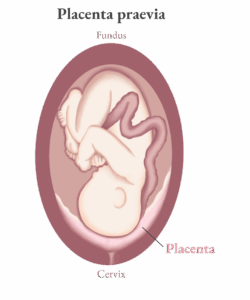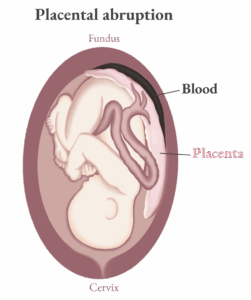The placenta is a temporary organ, unique to pregnancy. It forms after fertilization, when the egg implants in the wall of the uterus (the endometrium). This autonomous organ ensures a vital connection between mother and baby throughout pregnancy.
A bridge between mother and baby
Thanks to the umbilical cord, the placenta connects the mother’s bloodstream to that of the baby, preventing the two from mixing directly. It transports oxygen, carbon dioxide and nutrients essential to the healthy development of the fetus. It also acts as a filter, protecting the baby from potentially harmful substances (drugs, microbes, parasites) and playing a role in immune defense.
The mid-pregnancy ultrasound: a key moment
At the 20-week ultrasound (mid-pregnancy, morphological ultrasound), your healthcare professional will evaluate several elements, including the position of the placenta. He or she can tell you whether the placenta is marginal, low inserted, partial previa or complete previa.
Placenta implantation: variable positioning
When the fertilized egg is implanted in the endometrium of the uterus, the placenta is formed. The placenta ensures the fetomaternal circulation necessary for the growth of the baby and the progress of the pregnancy. However, there are several places where the placenta can develop, depending on the place of implantation.
During the ultrasound in the 20th week of pregnancy, your doctor will check where your placenta is located, so that he or she can advise the person monitoring your pregnancy to prevent any complications. The position of the placenta depends on where it was originally implanted. It may be :
- Low inserted, when it is located in the lower uterus, near the cervix.
- Marginal, when it touches the edge of the cervix.
- Partial prævia, when it partially covers the cervical opening.
- Complete prævia, if it completely covers the cervix.
Fortunately, in around 90% of cases, a low-lying or marginal placenta naturally “rises” as the uterus grows.

Follow-up and precautions in case of placenta previa
 When placenta previa is detected in mid-pregnancy, it does not necessarily mean a serious complication. However, careful monitoring is necessary. If you have already had a placenta previa in a previous pregnancy, the risk of recurrence is higher.
When placenta previa is detected in mid-pregnancy, it does not necessarily mean a serious complication. However, careful monitoring is necessary. If you have already had a placenta previa in a previous pregnancy, the risk of recurrence is higher.
In some cases, particularly if the placenta remains near or on the cervix at the end of pregnancy, your doctor may give you specific instructions in the event of bleeding. Ultrasound follow-up is generally scheduled for around 30-32 weeks to check on progress.
If the placenta remains in too low a position, a caesarean delivery will be recommended, often scheduled around 38 weeks, or earlier if symptoms (such as bleeding) occur.
The placenta after childbirth
Whether delivered vaginally or by Caesarean section, the placenta is removed after the baby is born. It is considered anatomical and biomedical waste, due to the risk of transmission of certain infectious diseases (HIV, hepatitis, etc.).
Other placental complications
 In addition to the question of its position, other conditions can affect placental function, such as :
In addition to the question of its position, other conditions can affect placental function, such as :
- Preeclampsia
- Placental abruption
- Intrauterine growth retardation (low birth weight)
- Late fetal loss
About one pregnancy in six is affected by a placental problem. That’s why monitoring the placenta is a priority throughout prenatal care.
In short : the placenta is a central organ for the health of the baby and the progress of the pregnancy. Although it can sometimes pose challenges, most situations are well managed with careful monitoring. By taking care of yourself, you’re also giving your baby the best possible start.
Marie Fortier
The Baby Expert
Reviewed by Catherine Belley, RN.
Updated article : April, 2025.
References :
-
Gouvernement du Québec. (2022). Placenta praevia et placentation anormale. CIUSSS de l’Est-de-l’Île-de-Montréal. Repéré le 8 avril 2025 à https://ciusss-estmtl.gouv.qc.ca/sites/ciusssemtl/files/media/document/placenta-praevia-placentation–cpsfe187%282022%29.pdf
-
Société des obstétriciens et gynécologues du Canada (SOGC). (2020). Ligne directrice n° 402 : Diagnostic et prise en charge du placenta praevia. Repéré le 8 avril 2025 à https://www.jogc.com/article/S1701-2163(19)30726-1/abstract
-
Parents.fr. (s. d.). Grossesse : le point sur les anomalies placentaires. Repéré le 8 avril 2025 à https://www.parents.fr/grossesse/sante/grossesse-pathologique/grossesse-le-point-sur-les-anomalies-du-placenta-78303
-
Lowdermilk, D. L., Perry, S. E., & Cashion, K. (s. d.). Soins infirmiers en périnatalité (2e éd.). Montréal : Chenelière Éducation.


